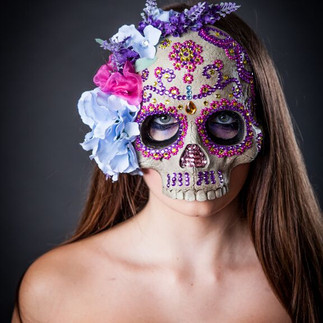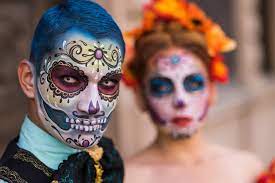
Halloween was always, as I remember, a real time of excitement. Not only did it promise the eating of so many sweets (the ONLY 'acceptable' time of which children are allowed to ring neighbours doorbells and demand sweet treats with menaces!) that you either went to bed feeling sick or you were unable to sleep due to the amount of E numbers consumed throughout your trawl of local 'terror.' Whilst many of us at some point in our life, normally as a child, have celebrated the tradition that is Halloween, how many of us know the true meanings and history behind this annual ghoulish festival?
Historical Halloween
There are a number of conflicting theories as to the origins of Halloween. With the word 'hallows' meaning saints, remarkably, the word we relate to ghosts and ghouls actually translates as All Saints Eve. Some scholars believe, the much celebrated Eve of All Hallows has Christian based origins and begins the observance of Allhallowtide (a celebratory 3 days celebration period within in a liturgical year) and is dedicated in remembering the dead, including saints and martyrs & faithful departed prior to All Hallows Day on November 1st. However, up until the 7th Century, All Hallows Eve actually fell on May 13, but, in a bid to distance the church with any Pagan occasions, Pope Boniface IV decided to change the observance of All Hallows Day to November 1st.
There is another theory and that is that the traditions may in fact be influenced by the Celts and their harvest festivals. With other scholars believing that Samhain, a Gaelic festival, with possible pagan roots, was the original tradition of both All Hallows Eve and Allhallowtide, that was in fact Christianised by the early church.
In ancient Celtic religion, Samhain is one the most important, yet sinister, calendar festivals of the year. The Gaelic festival, marking the end of the harvest season and the beginning of winter, was an all day affair that began and ended at sunset. With the cattle being brought down from the summer pastures and livestock slaughtered. Fraught with danger and charged with fear and supernatural occurrences, it is believed that the world of Gods, who were made 'visible' to humankind, would play tricks upon them.

Beltaines (special bonfires) were lit and were deemed to have cleansing and protective powers. Early literature says that this festival period was marked with great gatherings and feasts, and was a time when ancient burial mounds were opened. Spirits were given offerings of food and drink, in a bid to appease them and keep the farmers and their livestock safe over the coming winter months.
Whilst the traditions of Samhain have died out, a new and modern festival is now held in Edinburgh, Scotland, The Samhuinn Fire Festival. Bringing dance & music to the city, each year being hosted at a different location, and focusing on the changes of various aspects of life within the different seasons.
Up until the 1930's the Christian Halloween custom of 'Souling' (a tradition of singing for apples, ale, & soul cakes) was practiced. Both protestant and Catholic would go from parish to parish begging the rich for soul cakes, offering in exchange prayers for the souls of the rich that gave and their friends.
Day of the Dead
Like the Christian festival of Allhallowtide, Festival of the Dead is a 3 day celebration honouring the deceased which is held at the end of October to the beginning of November within many cultures such as Mexico, Europe & Africa. Believing that their dead family members come back in the dead of night to enjoy a night with their families before heading back to the afterlife. Whilst Halloween depicts terror and mischief, the celebrations of the traditional Mexican celebrations within the Festival and Day of the Dead are full of vibrancy and colour with singing, dancing and parades. Streets are painted with murals for participants to walk down, papel picado (elaborate perforated paper sheets) hang like strung up Christmas street lights and blow in the wind, whilst flowers and candles are laid in the masses for cemetery vigils.
Costumes
Whilst hundreds of years ago people would dress up as saints (within the Christian roots of the festival) and disguises (in the Samhain celebrations to hide from wandering souls) to celebrate. As the years have gone by things have changed dramatically and, like everything else, costumes have become more imaginative and even more scary.

With vampires, witches, skeletons, devils, spiders, toads, and cauldrons, all playing a huge part in how we celebrate today. I am sure, like me, most of you remember just how blown away we were when Michael Jackson's Thriller video hit our screens for the first time. This video, single handedly changed Halloween with the costumes bringing unimagined originality, it gave permission to push boundaries and imagination when dressing up as ghosts and ghouls.
Today, the incredible lengths that some people, including us adults go to to achieve THE most talked about costume is quite a thing. Not longer do people just don a white sheet, with holes for eyes and a completely painted white face with blackened eyes. No, no, no, with easily acquired spooky & terrifying contact lenses, home use prosthetic make-up, dramatic masks and headwear, we reenact scary characters from history movies and folklore.
Costumes for Festival & Day of the Dead celebrations are the most striking, in my opinion. With bold colours and brightly designed skull masks and headwear, eye catching costumes and ornately painted faces, the whole spectacle is one of pure vibrancy and really holds that carnival vibe.
Whilst during my younger years, it was only children, accompanied either by their parents or older siblings, that truly celebrated Halloween, it certainly wasn't something that adults wouldn't be party to (unless being involved with the children). Times have now changed and it is now seen as great excuse for adults to hunt out original costumes and party....WITHOUT the children!
Carving & Jack-O-Lanterns
The carving of pumpkins to sit on our doorstops and in our windows originates from an Irish myth. Legend has it that Stingy Jack tricked the Devil for monetary gain and when Jack died God forbid him from entering Heaven, sadly for Jack nor did the Devil let him into hell. He was therefore sentenced to roam the earth for eternity, stuck between two worlds. In a bid to frighten away Jacks wandering soul, the Irish would carve frightening faces out of turnips. It was when Irish immigrants moved the US that Jack-o-lanterns began to be carved from America's native pumpkins. Whilst the historical meaning of this tradition is to scare away the spirits, in todays celebrations, pumpkins are placed in windows to indicate that we are happy and well prepped with goodies for the trick or treating ankle biters to knock the door.
Trick Or Treat
Whilst its origins are murky, 'Trick or Treating' can be traced to ancient Celtic festivals, Roman Catholic Holidays and Medieval practices. It has been suggested that the now tradition evolved from a heritage of impersonating the spirits or souls of the dead and receiving offerings on behalf of these spirits. It is also believed that impersonating these spirits brought protection.
When my daughter was little, as we lived in a remote village, trick or treating was not easy, we would therefore host Halloween parties for school friends that were full of fun. The best game, I believe thought by the children, but for sure thought by the adults, was our special apple bobbing. Unlike the traditional, just catch the apple in a bucket of water with your teeth, this would have a four stage process. Apples in water, toads in flour, snakes in golden syrup & then sweets in flour. As you can imagine the mess was inconceivable, but what was even more inconceivable was it was the adults would also play this game, screaming with laughter as our faces would become a complete disarray of stickiness and smearing of all ingredients whilst the children looked on in utter dismay and even shock horror! They soon learnt the ways in our house at Halloween, so it was only ever the first year that any child would attend our Halloween festivities and be so alarmed!
Regardless, of any religious meaning, or the roots that these traditions stem, todays celebrations of both Halloween and Festival of the Dead are growing in popularity within the world. They are a fabulous excuse to dress up and have fun with friends and family, so whether you are a part-taker in the events of these annual celebrations or not, there is one sure thing, these historical traditions are set to stay, bringing fun and creativity in abundance and fabulous visual spectacles for all.
I will leave you all with the haunting 'Song of the Witches' from Shakespeare's Macbeth, as I heat up my cauldron and get ready to make my mischief & cast my spells!
Double, double toil and trouble;
Fire burn and caldron bubble.
Fillet of a fenny snake,
In the caldron boil and bake;
Eye of newt and toe of frog,
Wool of bat and tongue of dog,
Adder's fork and blind-worm's sting,
Lizard's leg and howlet's wing,
For a charm of powerful trouble,
Like a hell-broth boil and bubble.
Double, double toil and trouble; Fire burn and caldron bubble. Cool it with a baboon's blood, Then the charm is firm and good.
Rachael x
Orders are now being taken for custom designed masks & headpieces for Halloween & Festival of the Dead parties and events. Get in touch and discuss how we can be part of creating your spectacular costume. Last booking date for commissions for these events will be Wednesday 20th October 2021 Call 01273 966227 or email us on sales@avantgardecoutureuk.com.
%20FFF5F0.png)











תגובות